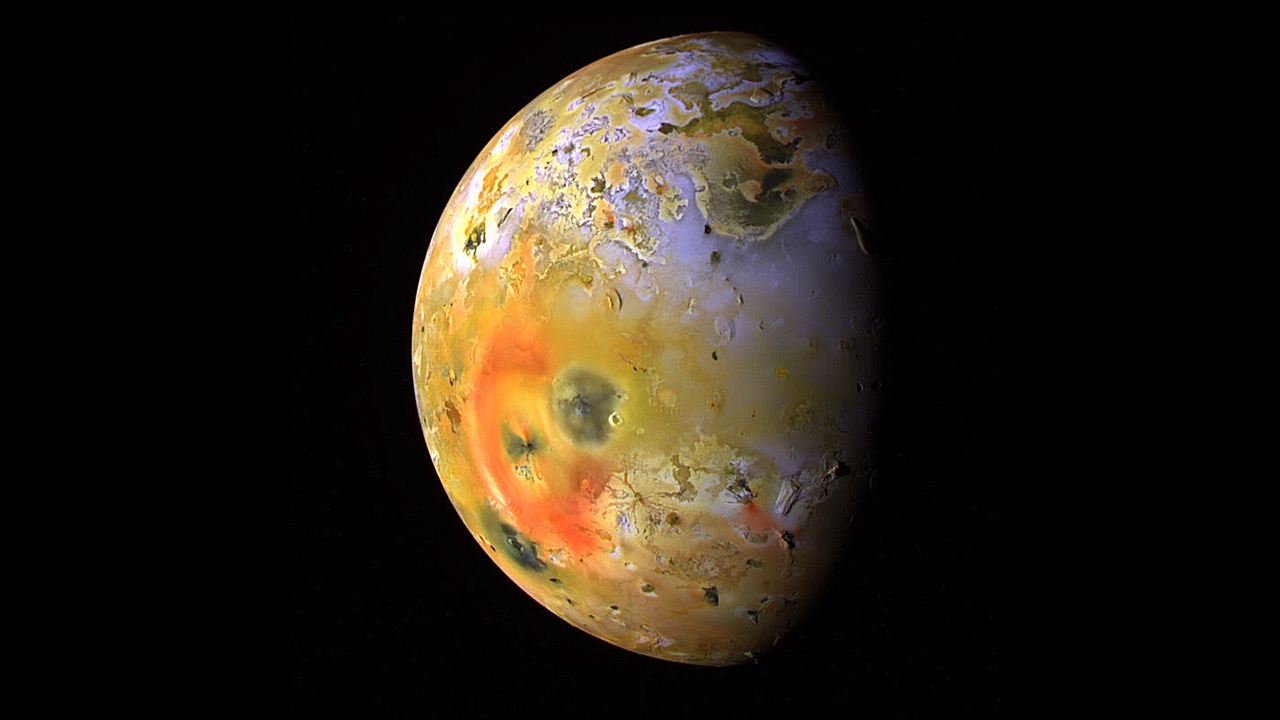News | November 9, 1995
Io: A Volcanic Puzzle

Galileo's primary mission success allowed scientists to study Io in greater detail than originally expected.
Editor's Note: The Galileo mission team wrote this article in 1995 before a mission extension allowed for additional risky flybys of volcanic Io. The original story is presented here as a historical record of an amazing, historic mission and is not updated to reflect the latest knowledge about Jupiter, the Galileo mission and our solar system. Enjoy.
On 7 December 1995, Galileo will have its one and only opportunity for a close encounter with Jupiter's moon Io, the most volcanically active body in the solar system. Io looks remarkably different from any other moon in the solar system, let alone any of Jupiter's other moons: there's nothing else in the solar system that looks like a planet-sized pepperoni pizza!
Like our own Moon, some of the Jupiter's 53 known moons are covered with impact craters, showing where meteorites smashed into the surface. But Io is covered with hundreds of volcanic craters which continually spew forth fresh material, resurfacing the entire moon every century. Some of this material escapes from Io's atmosphere and gets caught up in Jupiter's powerful magnetic field, forming a gigantic doughnut-shaped collection of particles orbiting around Jupiter known as the Io Plasma Torus. Io's fireworks are triggered by its tidal interactions with Jupiter and two of its other moons.
The distinctive yellow-orange color of the surface comes from sulfur (although Io looks like a pizza, it would smell like a rotten egg). How did Io's volcanoes evolve and what is there chemical composition? How frequently do they erupt? Is Io's crust thick or thin (still sounds like a pizza!), and what does that imply for all the volcanic activity. Scientists hope to use Galileo to answer these and other questions.
If Io is so interesting, then why is the spacecraft limited to one close flyby? Unfortunately, Io lies deep within Jupiter's radiation belts, and intense radiation environments are hazardous for spacecraft electronics. Additional passes might shorten the mission lifetime. One close pass, skimming a mere 1,000 km (about 600 miles) over Io's surface, is needed to so that gravitational attraction of Io will slow the orbiter -- the fourth gravity assist of the mission! This makes it possible for the spacecraft to enter orbit around Jupiter while using as little propellant as possible (Galileo uses its main engine as a brake, so braking uses up propellant that could be used for turning the spacecraft to point its communications antenna towards Earth, and for a turn that help position the spacecraft's cameras).
Volcanoes on Io and Earth: A Tale of Two Heat Sources
Io and Earth are two rocky solar system bodies that have volcanic activity. In both cases, the warm interior spurts up through weak chinks in the surface crust. But are Io and the Earth heated by the same process?
No. Earth's internal heat comes from the decay of radioactive elements. Small bodies like Io cannot retain enough heat from radioactive elements long enough to produce volcanoes today. Io's insides are heated instead by a tidal interaction process between Io, Jupiter and two other moons of Jupiter named Ganymede and Europa. Because Ganymede and Europa gravitationally tug on Io, Io's orbit around Jupiter is not perfectly circular. The resulting tidal tug on Io by Jupiter actually distorts Io's shape, which in turn heats Io's interior by frictional dissipation (to see this, try bending a piece of wire back and forth and feel how it heats up).
Jupiter itself also has a warm interior caused by leftover heat from its formation. Since Jupiter is mainly liquid and gas, the warm interior can move upwards towards the surface without volcanic activity.
